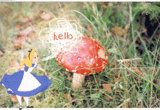Lucky for me it's only Thursday, and I still have plenty of time to catch up, oui?
First things first: what I've been doing lately.
I just finished with the feature story that fell into my lap a few weeks ago, which I call "Ice, Ice Baby." I'm not sure what my grade will be since I turned in the re-write (the first was a big, hairy B...), but I definitely feel good enough about it to share =]
*Ahem.*:
Ice, Ice Baby
The dead of winter is an icy time in St. Clair County. From the glacial build-up on
Lake Huron to the thick sheets covering the Black and St. Clair Rivers, locals have ice on all sides.
And yet, how much thought is really given the frozen element surrounding us?
At Knowlton’s Ice Museum of North America, the answer is: a whole lot.
The history of ice harvesting has very close ties to the Great Lakes, and even though the industry is mechanized today, Knowlton’s makes a unique effort to keep memories of the “iceman” days alive.
Knowlton’s Ice Museum, located at 317 Grand River Ave., not only features a collection of ice industry memorabilia spanning at least 30 years, but also provides their guests an original crash-course in the history of ice.
Judy Knowlton, who runs the museum “pretty much alone these days,” is a treasure trove of information all by herself. (She could be considered an exhibit…if “exhibit” weren’t such a potentially-insulting title to award a living, working person.)
The daughter of Norman F. “Mickey” Knowlton - who is the founder of Party Time Ice - Judy is full of cold, hard facts about the ice business and its history.
For instance: Did you know that ice, at one point, was one of the 10 largest industries in the U.S.? Or that there was a time when Port Huron had over 30 operating ice companies?
Judy Knowlton nurses a lifelong (possibly genetic) sentiment for the ice industry, and she has reserves of these kinds of facts just waiting to be accessed.
“We‘re one of the only museums dedicated to the natural history of harvesting ice-” is one of the first things Judy tells her patrons.
Before she begins an official tour, Judy leads visitors through the middle of the museum - passed rainbow walls of antique ice tongs, saws, chippers and crushers - to a small film-screening area, where everyone is treated to a 15-minute educational video called “The History of Ice Harvesting.”
“The History of Ice Harvesting” was made about three years ago and features Norman F. Knowlton, himself.
Pride for St. Clair County shines through the film’s every minute, and accordingly, it begins and ends the story of ice on the shores of Lake Huron.
According to film (later verified by Judy), in the late 1700’s and early 1800’s, farmers would chop out, and drag back to their barns large chunks of ice. They covered it with a little dirt and straw, and it would last through spring and summer.
Of course, something that useful - and pleasurable - can’t go unnoticed by society’s upper crust forever, and before long, the wealthy were buying quantities of ice from farmers to keep their drinks cool.
As of 1790, the film said, the farmers and the flush were the only people indulging in the luxury that was provided by storing ice. But a crazy business venture by a Bostonian merchant named Frederic Tudor would soon change that.
After a trip to the Caribbean, Tudor thought that he could make a fortune exporting ice from the lakes and ponds of his home state, Massachusetts, to Havana.
In 1806, The Tudor Ice Company successfully transported an 80-ton load of ice from Boston to Martinique.
And so the international ice trade began.
The 1807 Jeffersonian Embargo would cause the business’s rise to be slow, but it gained speed, seeing more success around 1817-1818. And soon delivering ice from northern states to warmer southern climates became the norm.
In 1833, ice was shipped from Massachusetts to India (then, a four-month voyage).
By the 1840’s ice was regularly being sent all over the world.
Here in the U.S., methods of ice harvesting had to improve to keep up with the explosion in the industry. And improve they did, when an American inventor named Nathaniel Jarvis Wyeth attached a metal saw to a horse and called it the “ice plow.“
According to “The History of Ice Harvesting,” crews of ice-cutters would scrape the ice clean of snow, and use the ice plow to mark the ice into a grid of identical 300-lb blocks. The blocks were then floated out and raised by ramps into ice houses for storing.
Most ice houses could store up to 10,000 tons of ice. It would take about two weeks to fill an ice house, and they used sawdust as an insulator, keeping the ice cold and fresh.
Judy reported that many ice houses still pepper the shores of northern lakes and rivers today.
In the movie, Norman Knowlton calls the whole process “heavy work. Dangerous work too.” But it was necessary work.
In 1861, the ice industry took another leap with the invention of the icebox - which Dictionary.com defines as “an insulated cabinet or chest with a partition for ice, used for preserving or cooling food, beverages, etc..”
Improved technology for harvesting and storage equaled cheaper, more efficient production. Because of this, the United States became the first country to have refrigeration become commonplace.
By the turn of the century, ice was a hot commodity - with Americans consuming more than two million tons of ice each year - and the iceman was a familiar sight on the streets of town.
Every week when the ice wagon made its rounds, housewives all over America were posting in their front windows the amount of ice they required - 25, 50, 75 or 100 lbs.
On sweltering summer days, children gathered in the street around the iceman’s truck, hoping for handouts of ice slivers.
Refrigeration completely transformed the American diet - before that, the only options for food preservation were salting, smoking, spicing or pickling - and the business of ice exploded.
At this time, companies such as the Lakeside Ice Co., Port Huron Ice, Canal Ice, the Purity Ice Co., and many others littered the Port Huron area.
Judy Knowlton’s eyes become as wide as saucers when she talks about the huge ice houses that sprung up along the Black River and Lake Huron…how the railroad had to get involved to help service the overwhelming demand. It‘s obviously a happy topic for her.
Unfortunately, even every great era must someday see its end.
As the populations of big, northern cities like Detroit grew, the waters became polluted.
The Downriver News Herald reported the Detroit River getting so bad that consuming ice from it meant risking developing Typhoid fever.
The industry started to start looking even further north; to cleaner waters and colder winters.
But it was with the 1913 invention of the Domelre, which stood for domestic electric refrigerator, that the ice industry took its final blow, and ice companies all over the country shuttered to a close - including the many here in Port Huron.
Today, ice is not harvested, it’s manufactured by big machines - 800 lbs per day.
Twenty-first century refrigerators, with their freezers and newfangled ice-makers, conveniently provide people with the ice they need for the home, but there is still a demand for commercially-made ice. It’s produced using one of several different modern processes. Then it’s bagged and shipped to warehouses, bars, party stores, and restaurants everywhere.
In 2004, the Knowlton family sold Party Time Ice to a national conglomerate, Arctic Glacier Premium Ice. But even though Arctic Glacier is the sole ice company in Port Huron these days, the Knowltons still work hard to ensure industry’s history here is not forgotten.
Knowlton’s Ice Museum of North America exists in perpetual tribute to the glory days of ice, and anyone can go there (by appointment only in the winter)!
You can learn about ice’s history and relation to Port Huron, listen to the bonanza of ice-knowledge that is Judy Knowlton, or just allow yourself to be swept away to an earlier time, when ice was something people waited for like milk, and Port Huron was part of the monstrous industry that supplied it.







No comments:
Post a Comment